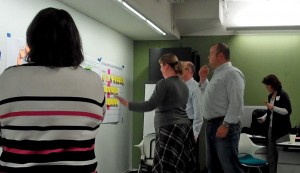I heard a song on the radio recently that was the closing video song for a very successful customer conference at my former company. This customer conference came on the heels of one that was a behind-the-scenes debacle (unnoticed by attendees, thankfully) because of bad project management techniques and poor project team performance. As memories came flooding back, this list of six project management techniques and associated mistakes I hope never to repeat came flooding back also.
 May you benefit from these lessons learned from previous project management technique mistakes!
May you benefit from these lessons learned from previous project management technique mistakes!
1. Having a project manager who isn’t a strong visual thinker
For one major program, our project manager was very good at checking things off a list and bugging people when they didn’t get things done. He couldn’t, however, anticipate project steps, potential dependencies within a project, and things that could go wrong. Ultimately, not being a strong visual thinker who could anticipate what the event experience would "look like" became a real problem, especially as we added new elements to the program he couldn’t effectively anticipate.
Lesson learned: It’s nice to have a project manager who is good at bugging people with a to-do checklist, but that skill alone isn’t enough.
2. Letting people sort through and grow into vague project management roles
When a project is starting up in a hurry, it’s easy to assign very loose project roles and tell everyone to get on with things. I’ve done this before in an effort to let people grow into bigger roles and take on responsibilities I might not have assigned to them. It works with a few individuals, but most often it leads to project break downs.
Lesson learned: One of the best investments of time you’ll make before a project starts is creating one paragraph descriptions of project roles for key project management team members so everyone is much clearer on expectations.
3. Forsaking “site” visits to save time and dollars
At various times, we’d forego a pre-event site visit to a property where we were planning events (which would have made us all better anticipatory thinkers) in the interests of saving money or time. Bad idea, because site visits help you anticipate problems and spark new creative ideas to take advantage of the space where you’ll be operating. Not all site visits are physical, however. Mindmapping a proposed process, service blueprinting a new customer experience, or engaging in online user experience testing are all versions of “site” visits.
Lesson learned: The time and dollars you save by not doing a site visit (whether physical or virtual) typically pale in comparison to the headaches and lost opportunities you will face later.
4. Waiting for direct evidence of a project team member’s negative behavior
I’m not a big believer in acting upon hearsay. Instead, I like to see proof with my own eyes of what’s being reported. At one point, a senior member on several project teams we had generated a lot of hearsay comments about his harsh, negative behavior. The thing was, in some very high pressure situations, I never saw him display the bad behaviors which others mentioned. As a result, I was WAY too slow to address it until it became a big personnel issue.
Lesson learned: “Where there’s smoke, there’s fire,” isn’t a misguided old saying.
5. Not asking enough of the right questions
I’ve been told previously by project team members I can be too hands-on when it comes to keeping on top of things. In reaction, I’ve made a concerted effort to try and give people more space to implement their own project management techniques and get the job done. As a result though, I’ve missed heading off issues that could have been identified with a few well-placed questions along the way.
Lesson learned: When the cues suggest a project team member is dropping the ball on something (and even if the cues are inconclusive), ask the basic questions in a non-threatening way so you’re not trying to recover when it’s too late.
6. Expecting miraculous performance improvements from team members
When you frequently work with the same people on projects you’ll see both strengths and weaknesses emerge individually and among the project management team. If you see a significant weakness displayed by a team member, I’ve learned to figure it’s the person (not the project) and act accordingly. Having been burned multiple times, it’s clear that It’s highly unlikely a different type of future project will suddenly fix (or at least mask) the weakness a project team member has displayed previously.
Lesson learned: If a weakness surfaces twice with a project team member, don’t expect a change of project scenery to fix it; invest the time with the team member to help improve project management technique deficiencies.
What project management technique mistakes do you hope to never repeat?
C’mon. I shared mine. What are yours? – Mike Brown
If you enjoyed this article, subscribe to the free Brainzooming blog email updates.
Does your organization have good ideas, but lacks the project management technique to bring them to reality? The Brainzooming Group and our collaborative, implementation-oriented project management techniques will quickly move you toward success. Email us at info@brainzooming.com or call 816-509-5320 for a free consultation on how to get started.



